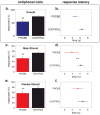Individual recognition during bouts of antiphonal calling in common marmosets
- PMID: 22277952
- PMCID: PMC3799814
- DOI: 10.1007/s00359-012-0712-7
Individual recognition during bouts of antiphonal calling in common marmosets
Abstract
Many vocalizations are encoded with a diversity of acoustic information about the signal producer. Amongst this information content are social categories related to the identity of the caller that are important for determining if and how a signal receiver may interact with that individual. Here, we employed a novel playback method in common marmosets (Callithrix jacchus) to test individual recognition during bouts of antiphonal calling. These experiments utilized custom, interactive playback software that effectively engaged subjects in antiphonal calling using vocalizations produced by a single individual and presented 'probe' vocalization stimuli representing a different individual at specific points within bouts of calling. The aim here was to test whether marmosets would recognize that the probe stimulus was a phee call produced by a different individual. Data indicated that marmosets were able to detect the change in caller identity; subjects produced significantly fewer antiphonal call responses to probe than control stimuli and, in some conditions, exhibited a shorter latency to produce the vocal response. These data suggest that marmosets recognize the identity of the individual during bouts of antiphonal calling. Furthermore, these results provide a methodological foundation for implementing the probe playback procedure to examine a broader range of social categorization during vocal interactions.
Figures



Similar articles
-
Antiphonal call timing in marmosets is behaviorally significant: interactive playback experiments.J Comp Physiol A Neuroethol Sens Neural Behav Physiol. 2009 Aug;195(8):783-9. doi: 10.1007/s00359-009-0456-1. Epub 2009 Jul 12. J Comp Physiol A Neuroethol Sens Neural Behav Physiol. 2009. PMID: 19597736 Free PMC article.
-
Contact calls of common marmosets (Callithrix jacchus): influence of age of caller on antiphonal calling and other vocal responses.Am J Primatol. 2009 Feb;71(2):165-70. doi: 10.1002/ajp.20636. Am J Primatol. 2009. PMID: 19026011
-
The communicative content of the common marmoset phee call during antiphonal calling.Am J Primatol. 2010 Nov;72(11):974-80. doi: 10.1002/ajp.20854. Am J Primatol. 2010. PMID: 20549761 Free PMC article.
-
Sensory-motor interactions modulate a primate vocal behavior: antiphonal calling in common marmosets.J Comp Physiol A Neuroethol Sens Neural Behav Physiol. 2006 Jan;192(1):27-38. doi: 10.1007/s00359-005-0043-z. Epub 2005 Aug 31. J Comp Physiol A Neuroethol Sens Neural Behav Physiol. 2006. PMID: 16133500
-
The autonomic nervous system is the engine for vocal development through social feedback.Curr Opin Neurobiol. 2016 Oct;40:155-160. doi: 10.1016/j.conb.2016.07.016. Epub 2016 Aug 13. Curr Opin Neurobiol. 2016. PMID: 27525350 Free PMC article. Review.
Cited by
-
Perceptual specializations for processing species-specific vocalizations in the common marmoset (Callithrix jacchus).Proc Natl Acad Sci U S A. 2023 Jun 13;120(24):e2221756120. doi: 10.1073/pnas.2221756120. Epub 2023 Jun 5. Proc Natl Acad Sci U S A. 2023. PMID: 37276391 Free PMC article.
-
Optogenetic manipulation of neural circuits in awake marmosets.J Neurophysiol. 2016 Sep 1;116(3):1286-94. doi: 10.1152/jn.00197.2016. Epub 2016 Jun 22. J Neurophysiol. 2016. PMID: 27334951 Free PMC article.
-
Active vision in marmosets: a model system for visual neuroscience.J Neurosci. 2014 Jan 22;34(4):1183-94. doi: 10.1523/JNEUROSCI.3899-13.2014. J Neurosci. 2014. PMID: 24453311 Free PMC article.
-
Responses of primate frontal cortex neurons during natural vocal communication.J Neurophysiol. 2015 Aug;114(2):1158-71. doi: 10.1152/jn.01003.2014. Epub 2015 Jun 17. J Neurophysiol. 2015. PMID: 26084912 Free PMC article.
-
The role of extragroup encounters in a Neotropical, cooperative breeding primate, the common marmoset: a field playback experiment.Anim Behav. 2018 Feb;136:137-146. doi: 10.1016/j.anbehav.2017.12.009. Epub 2018 Feb 6. Anim Behav. 2018. PMID: 37065636 Free PMC article.
References
-
- Aubin T, Jouventin P. Cocktail-party effect in king penguin colonies. Proc R Soc, B. 1998;265:1665–1673.
-
- Aubin T, Jouventin P. How to vocally identify kin in a crowd: the penguin model. Adv St Beh. 2002;31:243–277.
-
- Bee MA, Gerhardt HC. Neighbour-stranger discrimination by territorial male bullfrogs (Rana catesbeiana): I. acoustic basis. Anim Behav. 2001a;62:1129–1140.
-
- Bee MA, Gerhardt HC. Neighbour-stranger discrimination by territorial male bullfrogs (Rana catesbeiana): II. perceptual basis. Anim Behav. 2001b;62:1141–1150.
Publication types
MeSH terms
Grants and funding
LinkOut - more resources
Full Text Sources
Miscellaneous

